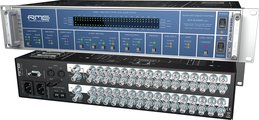The ADI-6432R BNC provides 64 channels of format conversion from MADI to AES-3id and vice versa.
Based on RME's highly successful bidirectional MADI-AES/AES-MADI converter ADI-6432, the newly developed ADI-6432R BNC offers broadcasters ease of integration and fail-safe operation through the utilization of industry standard BNC connectors and dual redundant power supplies, while offering 64 channels of I/O capability. The BNC version targets broadcast and professional users who require AES-3id connections - coaxial 75 Ohm cables with up to 300m length.
Typical applications include two ADI-6432R used as digital multicore, or one unit used as AES-3id frontend for the HDSPe MADI card. Up to 192 kHz at 24 bits is supported. Built in 2 height units the ADI-6432R BNC provides enough space for all connectors and control elements. Of course the unit includes lots of typical RME features:
- Support for up to 192 kHz with MADI and AES
- Unique status displays for MADI and AES
- SteadyClock for maximum jitter reduction and clock regeneration
- Completely remote controlable via MIDI
- Transfer of MIDI data via MADI
- Transfer of RS232 data via MADI
- Redundant power supply
AES-3id, an extension to the AES-3 standard also known as AES/EBU, carries the exact same data as the latter, but uses a different cable (75 Ohm unbalanced instead of 110 Ohm balanced) with different connectors (BNC instead of XLR) and lower voltage (1 Vpp instead of 4 Vpp). Therefore, the ADI-6432R BNC has 64 BNC connectors on its back.
As with every RME MADI converter, the ADI-6432R BNC provides both coaxial (BNC) and optical (SC plug to Multimode glass fiber) MADI connectors. MADI handles 64 channels of 24-Bit audio at sampling frequencies up to 48 kHz, 32 channels up to 96 kHz, and 16 channels up to 192 kHz. All channels are transferred across a single cable, either coaxial (BNC) or optical network cable. In both cases, cable lengths of more than 100 meters can be achieved. The ADI-6432R accepts 56 channels and 64 channels as well as 96k frame at its input, and can be set to generate those formats at its output.
As an option, the ADI-6432R is also available with Single Mode MADI connectors, which make the ADI-6432R BNC compatible to existing single-mode networks and to MADI signal distribution over extremely long distances (up to 10km).
RME's SteadyClock(TM) lets the ADI-6432R use MADI without an additional word clock connection, and guarantees excellent clock quality in every situation. Due to the highly efficient jitter reduction, any clock signal - even AES and word - can be improved and refreshed, and subsequently be used as reference clock at the unit's outputs. will retain the last valid sample frequency in case of a loss of the input signal.
The ADI-6432R supplies word clock in Single, Double und Quad Speed, distributes Double Wire 96 kHz signals into the MADI data stream, and even supports the double MADI sample rate (96K frame). The ® and ® technologies known from other RME products ensure perfect synchronization and clear detection of errors. Also multiple units can be stacked and operated sample-aligned, using word clock. All settings are stored when the unit is switched off.
A fully automatic input selection between optical and coaxial input offers a useful redundancy mode for critical applications. Extensive status displays give information about lock and sync states, audio content and the physical quality of the incoming signal.
The front panel features an exciting and detailed sync and audio state display with 97 LEDs. Furthermore every function has its own keys accompanied by clear function LEDs. Especially in a professional application, exact, quick and direct control and display of all incoming and outgoing signals, including MIDI and RS232, becomes indispensable. Errors can be detected at a glance. The control keys can be locked to prevent accidental changing of settings.
The ADI-6432R BNC has a redundant power supply which can be connected to two different electrical circuits. If one of these circuits fails, the ADI-6432 R BNC will continue to operate normally.
16 MIDI channels can be transferred invisibly across MADI, at the full count of 64 audio channels. The same applies to RS232: Be it 9600, 19200 or 115200 Baud, thanks to a 9-pin COM port, the ADI-6432R can be used as an extender for serial cables, with no effect on the audio functionality.
Additionally the device can be fully remote controlled and configured via MIDI, and all status displays can be queried through MIDI. Each ADI-6432R can be given a separate ID, allowing separate remote controllability of various devices with only one MIDI channel.
The ADI-6432R is compatible to any MADI interface from other companies, like Sony, Merging, Lawo, Euphonix, Stagetec, Jünger, Audio Service, AMS and others.
Input/Output MADI: 1 x BNC, 1 x optical
Input AES-3id: 32 x BNC (coaxial 75 Ohm)
Output AES-3id: 32 x BNC (coaxial 75 Ohm)
Input word clock: BNC, Signal Adaptation Circuit (functional from 1.2 Vpp)
Output word clock: BNC, low impedance driver stage, 4 Vpp into 75 Ohms, short-circuit-proof
MIDI input and output: via two 5-pin DIN jacks
COM port: RS232 via 9-pin D-sub, 9600/19200/115200 Baud
Sync sources: MADI, AES, word clock, internal
Varipitch: by input signal or word clock
Sample frequencies: 44.1 kHz, 48 kHz, 88.2 kHz, 96 kHz, 176.4 kHz, 192 kHz, variable (sync/word clock)
Sample rate range: MADI: 32 - 192 kHz, word clock: 27 kHz - 200 kHz, AES: 28 kHz - 200 kHz
Jitter: Internal Clock < 1 ns, Word Clock In < 2 ns, AES-3id In < 2 ns
Jitter suppression: >30 dB (2.4 kHz)
Jitter sensitivity: all PLLs operate error-free even at 100 ns
Power supply: Internal switching mode PS, 100V - 240V AC, 20 Watt
Dimensions: (WxHxD) 483 x 88 x 200 mm






